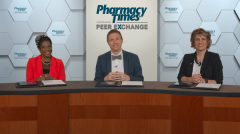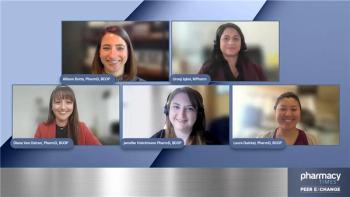
Barriers Inhibiting Optimal Pneumococcal Vaccination Rates
Medical experts discuss clinical, social, and economic obstacles limiting pneumococcal vaccination efforts.
Episodes in this series

Ryan Haumschild, PharmD, MS, MBA: We’ve talked a lot about vaccinations—the importance of them, and the different products available—and you’ve created a great platform. But we also recognize that we need to address the barriers to pneumococcal vaccination. Dr Bridgeman, what are the potential obstacles related to administering these new pneumococcal vaccinations, whether it’s payer coverage or any patient hesitancy?
Mary Bridgeman, PharmD, BCPS, BCGP, FASCP: Increasing adult and childhood vaccination rates are a key health priority in the United States. This is evident in the Healthy People 2030 goals. It’s a clear priority. There are data from the CDC [Centers for Disease Control and Prevention] and from the National Health Interview Survey that let us know how we’re doing with pneumococcal vaccination rates. Of course, there’s a bit of a lag in terms of the data reporting, but we have data from prior to the COVID-19 pandemic—2019 and 2020 data estimates—that suggest that coverage among individuals aged 65 and older was around 70% for the pneumococcal vaccinations. It was 67.5% in 2020 for pneumococcal vaccination rates overall. That’s anyone who’s received 1 dose of PPSV23 [pneumococcal polysaccharide vaccine] or PCV13 vaccine [pneumococcal conjugate vaccine] among individuals aged 19 to 64 years at an increased risk of pneumococcal infection. The immunization rate in this particularly vulnerable population was 23.3% in 2020.
Vaccine coverage rates tend to be higher for individuals who are White compared with individuals from racial or ethnic minority groups. This is a key message that we need to consider: individuals from certain ethnic and racial minority groups are disproportionately affected when it comes to receiving the recommended vaccines. We have to prioritize and address health disparities. We talked about this a little earlier in regard to the differences in immunization rates, health care access, and vaccine uptake. These are some key priorities and potential barriers. We saw issues with vaccine equity come to light and brought to the forefront during the COVID-19 pandemic. It’s undeniably a multifactorial issue. We’re talking about establishing trust in health care professionals, and that’s not an easy challenge to tackle.
[Regarding] ensuring access, we talked before about mobilizing vaccine availability, meeting individuals where they are—in their communities, in their homes—partnering with community organizations, and simplifying the procedures for individuals to be able to access vaccines. What information is required upon registration to receive an immunization? We need to increase awareness of some of the programs that Dr Madison made reference to—the Vaccines for Children and [Section] 317 programs—are some critical aspects for addressing some of these challenges. We should be considering strategies to promote vaccine awareness. This isn’t just the pneumonia shot, and I hope that’s a key takeaway. Pneumococcal disease can really be significant. We talk about the invasive disease, especially throughout this presentation. As pharmacists, we’re positioned to copromote influenza vaccine alongside pneumococcal or other seasonally appropriate vaccines for our patients in the name of patient and public health. Utilizing every interaction, we talked about missed opportunities. At every interaction with the health care system, whether it’s hospitalization, a clinic visit, or an ambulatory experience, it’s key that we reconcile immunization history. Then we can promote appropriate vaccination if indicated at that time.
Christina Madison, PharmD, FCCP, AAHIVP: [I have] reconciled many vaccine records that came out of the family Bible from a very long time ago. It’s imperative that we take all those records because you might not have access to their primary care provider or pediatrician wherever they went. I’ve worked so many back-to-school clinics where I had to acquire these records, and it’s definitely challenging. Empower your patient to make sure they have access to their vaccination records, that they’re as up-to-date as possible. Make it easy for them. We can have those instances where you have a patient portal or an app system so individuals can easily access their records, which is what we did with COVID-19.
Mary Bridgeman, PharmD, BCPS, BCGP, FASCP: Absolutely.
Christina Madison, PharmD, FCCP, AAHIVP: We just did this with the COVID-19 passport. You can go in and get it, and now you can say what vaccinations you have. We’re getting better, but to go back to your point about the health disparities and inequities, I don’t even say shine a light on it because it was already there, but it’s the giant black light that illuminated everything that was already there. We just weren’t paying attention.
Mary Bridgeman, PharmD, BCPS, BCGP, FASCP: I love it. I want to go back to leveraging the electronic medical record and patient portals. This is another strategy to ensure patients are invested in their immunization history, so they’re not looking in the kitchen drawer or trying to track down those health records. We used to have a ceramic chicken in my kitchen. It was the cookie jar where health records were stored as a kid. It’s critical to leverage technologies that are available to us.
Ryan Haumschild, PharmD, MS, MBA: There’s a lot to unpack there. You hit on a lot of great comments. The No. 1 thing is we need to empower patients to be active in their journey. There’s a lot we can do as health care providers. There’s a lot more we should be doing as health care providers, but how do we engage the patients as part of their care? At the end of the day, we need them to be motivated to stay up to speed on their immunizations, engage with their providers, and be willing to overcome vaccine hesitancy. That’s an important key piece.
When I think about engaging patients where they’re at, it’s coming to their communities—their places of faith, their churches—and making sure we’re talking to them about the disease as a whole. Not just telling them when to come in because we want them to feel empowered. Those are strategies that have been proven through public health to draw out patients and draw out that information. One of the other key considerations that’s coming up more is “Walk with a doc,”—having 1 of the physicians they’re familiar with coming into their community and walking through the local park and having a 1-on-1 interaction. That allows them to humanize the information they’re hearing, not just someone being more parental and talking to them about the best practices.
Transcript edited for clarity.
Newsletter
Stay informed on drug updates, treatment guidelines, and pharmacy practice trends—subscribe to Pharmacy Times for weekly clinical insights.



















































































































































































































